parasitic; feeds on hemolymph of developing honey bees (inside capped brood cells)
Euvarroa Delfinado and Baker, 1974Delfinado and Baker, 1974:
Delfinado, M. D. amp; E. W. Baker. 1974. Varroidae: A new family of mites on honeybees (Mesostigmata: Acarina). Journal of Washington Academy of Sciences.64: 4-10.
Superorder Parasitiformes » Order Mesostigmata » Suborder Monogynaspida » Hyporder Dermanyssiae » Family Laelapidae » Genus Euvarroa
Euvarroa sinhai Delfinado and Baker, 1974Delfinado and Baker, 1974:
Delfinado, M. D. amp; E. W. Baker. 1974. Varroidae: A new family of mites on honeybees (Mesostigmata: Acarina). Journal of Washington Academy of Sciences.64: 4-10.
Female: Gnathosomagnathosoma:
Division of body anterior to the propodosoma bearing two pairs of appendages (palps and chelicerae).
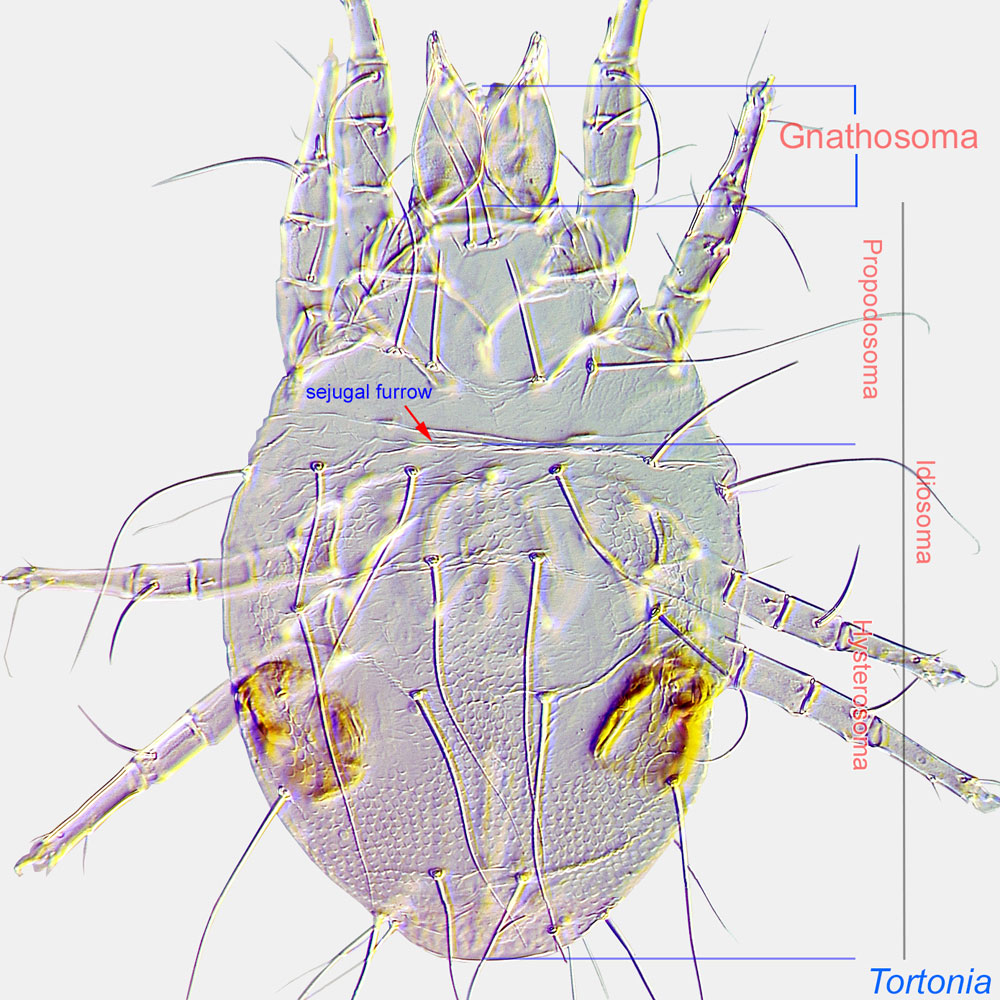 with 3 pairs of hypostomal setae (similar to those of Varroa). IdiosomaIdiosoma:
with 3 pairs of hypostomal setae (similar to those of Varroa). IdiosomaIdiosoma:
Body not including the gnathosoma.
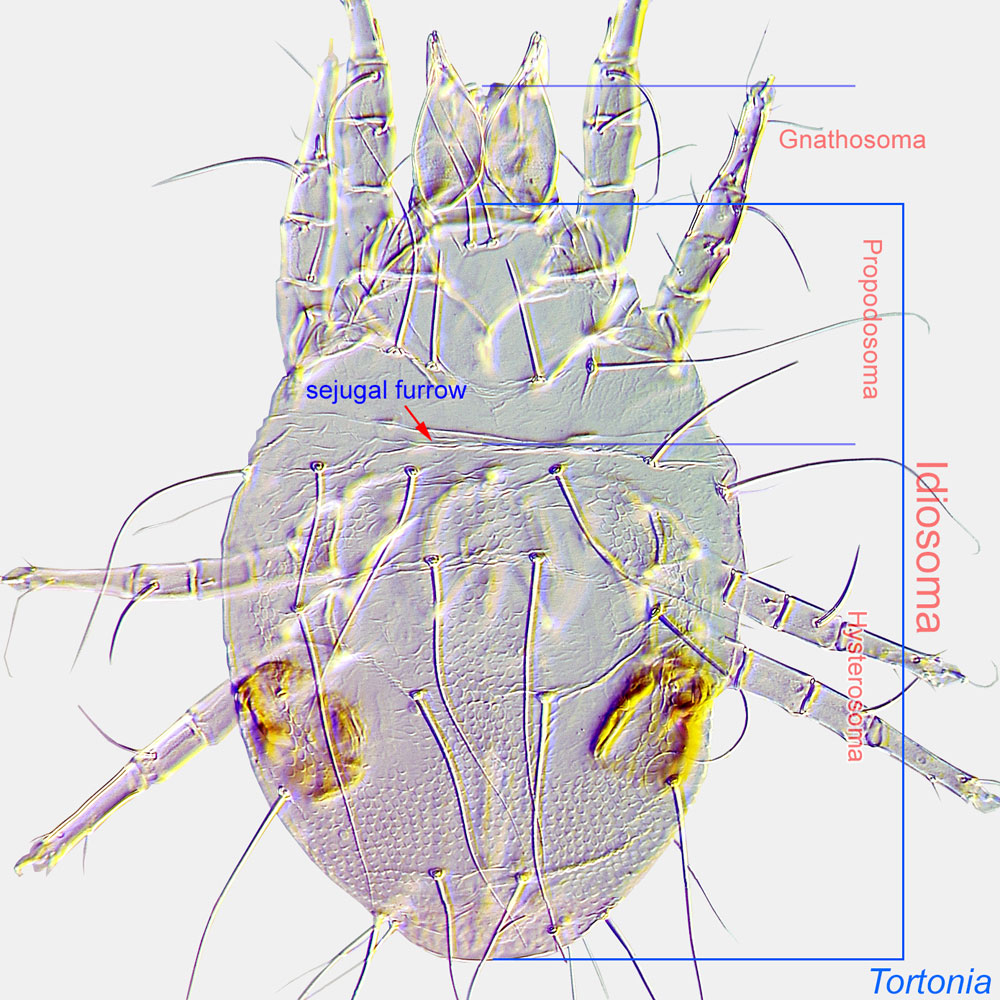 not transversely oval in outline (Figs. 1, 2), hypertrichoushypertrichous:
not transversely oval in outline (Figs. 1, 2), hypertrichoushypertrichous:
With many irregularly arranged setae.
(Figs. 1, 2). Exopodal IV and metapodal shieldsmetapodal shield:
In Mesostigmata, a pair (sometimes fused) of small sclerites posterior to coxae IV in the ventral region.
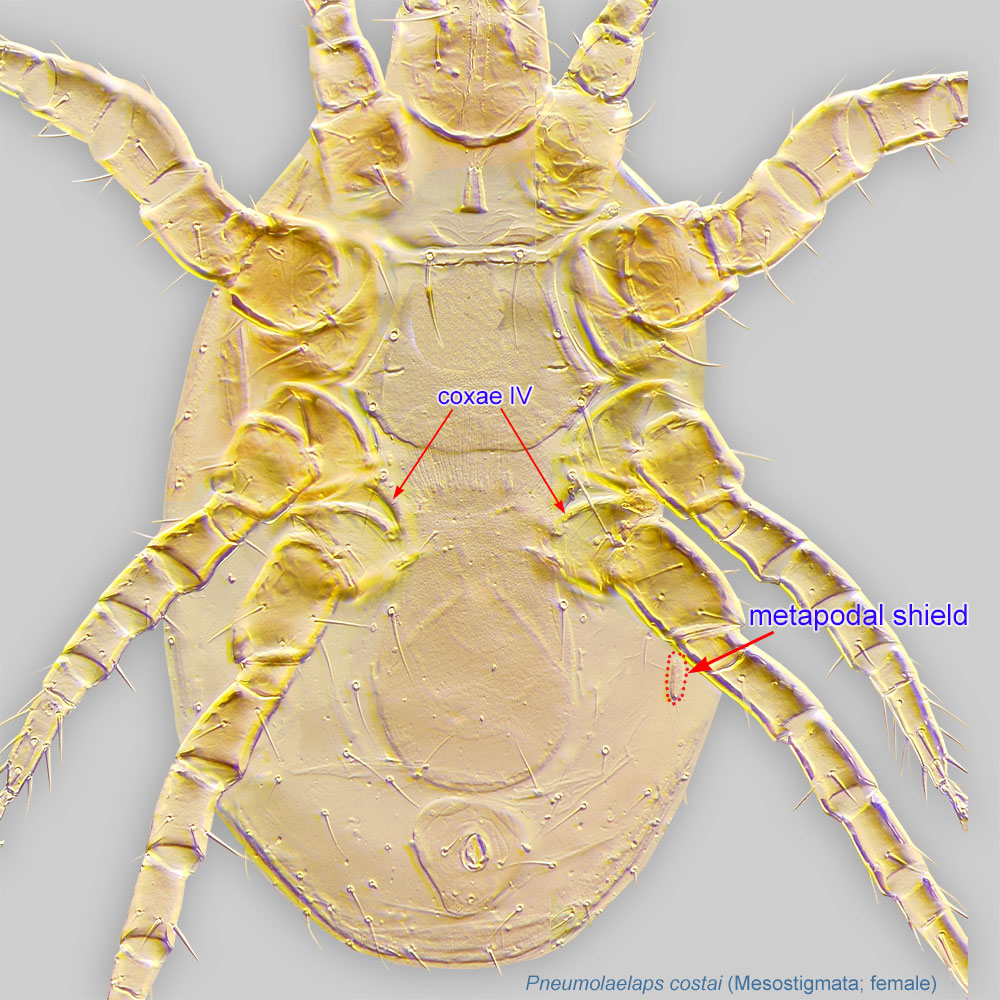 not enlarged, not covering entire ventral opisthosomaopisthosoma:
not enlarged, not covering entire ventral opisthosomaopisthosoma:
Body division posterior to legs IV; usually there is no distinct boundary delimiting this part of idiosoma.
(Fig. 2). Epigynal and metapodal shieldsmetapodal shield:
In Mesostigmata, a pair (sometimes fused) of small sclerites posterior to coxae IV in the ventral region.
 almost touching (Fig. 2). Anal opening terminal, not visible ventrally (Fig. 2).
almost touching (Fig. 2). Anal opening terminal, not visible ventrally (Fig. 2).
Dichotomous keys are not currently available. Delfinado and Baker, 1974Delfinado and Baker, 1974:
Delfinado, M. D. amp; E. W. Baker. 1974. Varroidae: A new family of mites on honeybees (Mesostigmata: Acarina). Journal of Washington Academy of Sciences.64: 4-10.; Lekprayoon and Tangkanasing, 1991Lekprayoon and Tangkanasing, 1991:
Lekprayoon, C. amp; P. Tangkanasing. 1991. Euvarroa wongsirii , a new species of bee mite from Thailand. International Journal of Acarology.17: 255-258.; and Morin and Otis, 1993Morin and Otis, 1993:
Morin, C. E. amp; G. W. Otis. 1993. Observations on the morphology and biology of Euvarroa wongsirii (Mesostigmata: Varroidae), a parasite of Apis andreniformis (Hymenoptera: Apidae). International Journal of Acarology.19: 167-172. should be referenced for identification of the two known species: Euvarroa sinhai Delfinado and Baker, 1974Delfinado and Baker, 1974:
Delfinado, M. D. amp; E. W. Baker. 1974. Varroidae: A new family of mites on honeybees (Mesostigmata: Acarina). Journal of Washington Academy of Sciences.64: 4-10. and Euvarroa wongsirii Lekprayoon and Tangkanasing, 1991Lekprayoon and Tangkanasing, 1991:
Lekprayoon, C. amp; P. Tangkanasing. 1991. Euvarroa wongsirii , a new species of bee mite from Thailand. International Journal of Acarology.17: 255-258..
Similar to Varroa. Differences (character states of Varroa are shown in parentheses): idiosomaidiosoma:
Body not including the gnathosoma.
 not transversely oval (transversely oval); exopodal IV and metapodal shieldsmetapodal shield:
not transversely oval (transversely oval); exopodal IV and metapodal shieldsmetapodal shield:
In Mesostigmata, a pair (sometimes fused) of small sclerites posterior to coxae IV in the ventral region.
 not enlarged, not covering entire ventral opisthosomaopisthosoma:
not enlarged, not covering entire ventral opisthosomaopisthosoma:
Body division posterior to legs IV; usually there is no distinct boundary delimiting this part of idiosoma.
(enlarged and, together with epigynal shieldepigynal shield:
A shield protecting the female genital opening. Well-developed in Mesostigmata. Also known as epigynial shield.
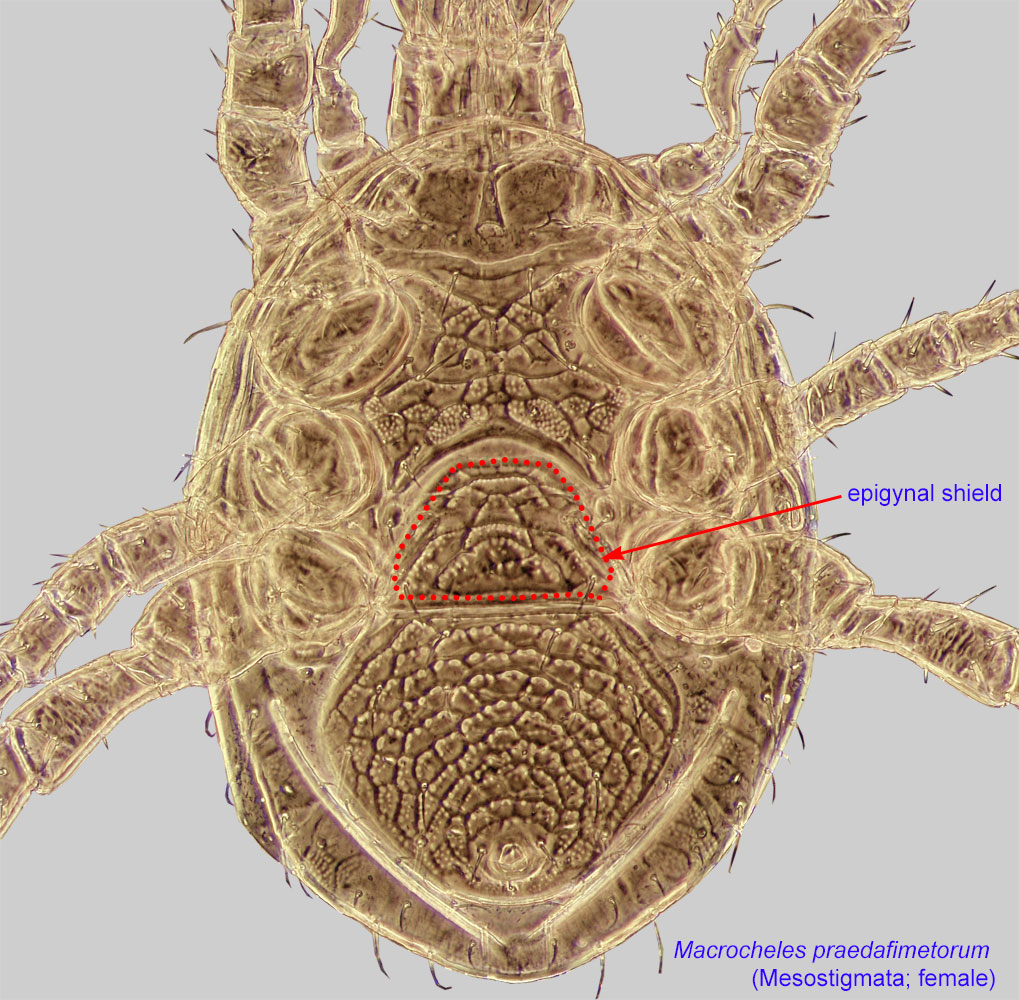 , cover almost entire ventral opisthosomaopisthosoma:
, cover almost entire ventral opisthosomaopisthosoma:
Body division posterior to legs IV; usually there is no distinct boundary delimiting this part of idiosoma.
); anal shieldanal shield:
In Mesostigmata, a ventral shield bearing the anal opening and circumanal setae (adanal or postanal setae), but without any ventral setae or pores (lyrifissures) on it. If ventral setae are present on shield than referred to as a ventrianal shield.
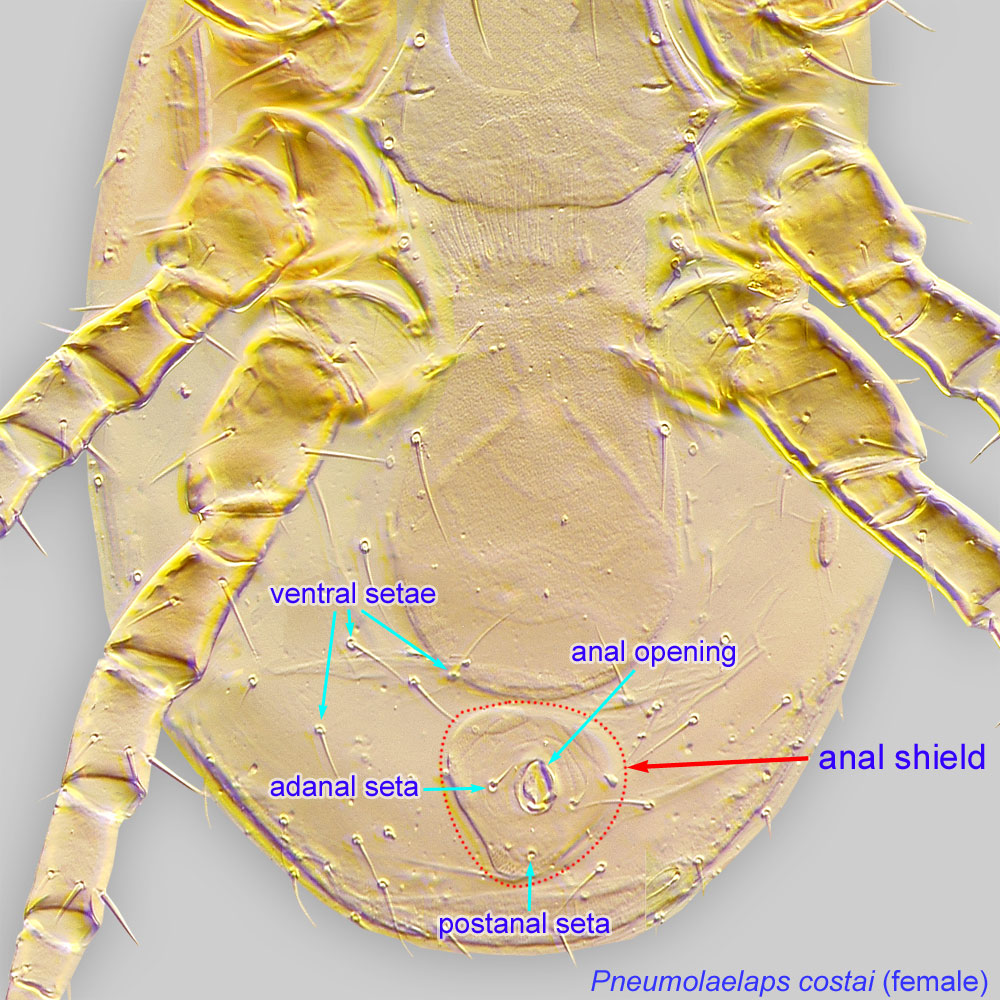 terminal, not visible ventrally (ventral, visible ventrally).
terminal, not visible ventrally (ventral, visible ventrally).
Asia from Iran through India to Sri Lanka; Thailand and Malaysia
honey bees (Apis)
permanentpermanent:
associated exclusively with bees or their close relative, wasps; cannot live without these hosts
The biology of the two species in this genus is summarized after Sammataro et al., 2000Sammataro et al., 2000:
Sammataro, D., U. Gerson amp; G. Needham. 2000. Parasitic mites of honey bees: life history, implications, and impact. Annual Review of Entomology. 45: 519-548.. Euvarroa sinhai is a parasite of Apis florea, occurring in Asia from Iran through India to Sri Lanka. The mite develops naturally on the capped drone brood but has been reared in the laboratory on A. mellifera worker brood. Development requires less than one week, and each female produces four to five offspring. Drones as well as workers are used for dispersal. The female mite overwinters in the colony, probably feeding on the clustering bees. Colony infestation by E. sinhai is somewhat hindered by the construction of queen cells, and its population growth is inhibited in the presence of Tropilaelaps clareae and Varroa destructor. Transfer experiments confirmed that E. sinhai may survive on A. mellifera and A. cerana, emphasizing its ability to cross-infest exotic hosts.
Euvarroa wongsirii parasitizes drone brood of Apis andreniformis in Thailand and Malaysia. Its biology appears similar to E. sinhai, and it can live for at least 50 days on worker bees outside the nest.